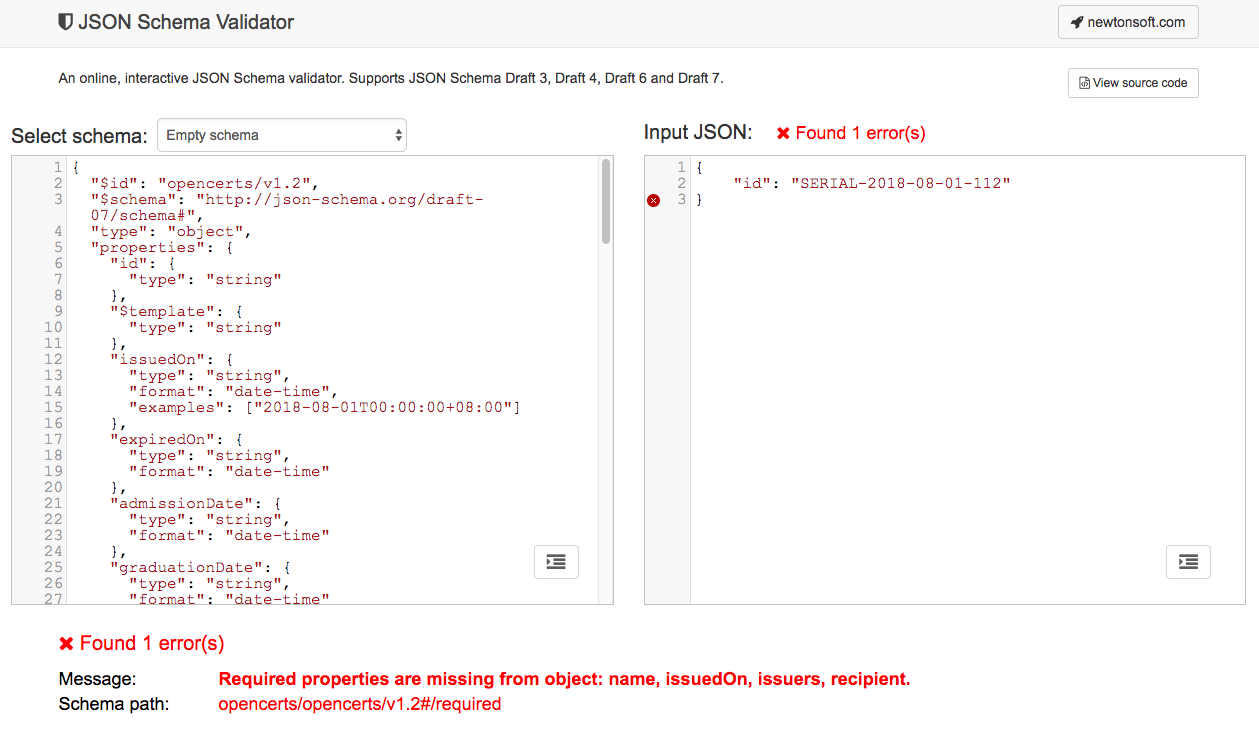opencerts-documentation
Creating Certificates

The OpenCerts file is a .json file that conforms to the OpenAttestation specification.
At the root level, each file contains information on the schema type (OpenCerts), certificate data, hidden data (from privacy filter) and a signature. Details of the OpenAttestation file format can be found on the Github page.
What you will be most concern with is the certificate data. All these data are stored in the data key on the OpenCerts file and conforms to the OpenCerts schema.
For this section, we will focus on populating the certificate data that conforms to the schema.
OpenCerts Schema
The shape of the certificate object is defined using JSON Schema. The definition can be found at https://github.com/OpenCerts/open-certificate/blob/master/schema/1.5/schema.json.
Using JSON Schema Validator
An useful online tool to help you understand the JSON schema is the JSON Schema Validator.
Simply paste the content of the schema document on the left panel and you can start writing the certificate data on the right. The tool will instantly validate the certificate data shape and will notify you of potential errors.

You can see that the validation failed because of missing properties on JSON Schema Validator
The Minimalist Certificate
{
"id": "2018091259",
"name": "Bachelor of Blockchain",
"issuedOn": "2018-08-01T00:00:00+08:00",
"issuers": [
{
"name": "University of Blockchain",
"certificateStore": "0x1989a05B320186f5fAc590fFf64730FC9099Bc7b"
}
],
"recipient": {
"name": "John Snow"
}
}
The simplest certificate contains the values for id, name, issuedOn, issuers and recipient.
Try creating a minimal certificate using the tool above to get an idea of what goes into a certificate.
id Field
The id field is a string used to uniquely identify the certificate. In most cases, the serial number of the corresponding physical certificate can be used.
Alternatively, a random uuid can be generated and used here.
name field
The name field is a string that refers to the name of the certificate.
issuedOn field
The issuedOn field is a date-time string conforming to the ISO 8601, RFC 3339 format.
Example of a valid issuedOn string is 2018-08-31T23:59:32+08:00. Where it specifies the date-time (HH:MM:SS) 23:59:32, on 31/08/2018, in the timezone GMT +8.
issuers field
The issuers is an array of the issuer object. The required fields for each issuer is name and certificateStore. Other fields such as did, url, email and phone are also recognised.
The name specifies the name of the issuing body while the certificateStore specifies the smart contract address of the certificate store deployed by the issuing body.
The certificateStore address can be obtained after deploying an instance of the smart contract.
recipient field
The recipient is an object of the recipient. The only required field is name while other properties such as did, url, email and phone are available.
The Complete Certificate
Once you are done with the minimal certificate, you can include more data such as transcript and additionalData into the certificate.
{
"id": "2018091259",
"name": "Bachelor of Blockchain",
"issuedOn": "2018-08-31T23:59:32+08:00",
"issuers": [
{
"name": "University of Blockchain",
"url": "https://universityofblockchain.com",
"certificateStore": "0x1989a05B320186f5fAc590fFf64730FC9099Bc7b"
}
],
"recipient": {
"name": "John Snow",
"email": "johnsnow@gmail.com",
"phone": "+6588888888"
},
"transcript": [
{
"name": "History of Blockchain",
"grade": "B+",
"courseCredit": 3,
"courseCode": "HIST-BTC",
"url": "https://universityofblockchain.com/sub/hist-btc",
"description": "Understanding the origins of the blockchain."
},
{
"name": "Ethereum Smart Contracts",
"grade": "A",
"courseCredit": 3,
"courseCode": "ETH-SC",
"url": "https://universityofblockchain.com/sub/eth-sc",
"description": "Understanding how to write smart contracts on the Ethereum network."
}
],
"additionalData": {
"signature": "data:image/jpeg;base64...."
}
}
transcript field
The transcript field is an array of transcript objects. Each object is required to have the name value and can optionally hold values for grade, courseCredit, courseCode, url, description and score.
Additional properties can also be added to the transcript objects.
additionalData field
Can’t find any place to insert data into? additionalData is the right place to put it.
The additionalData field is an object that allows you to insert any type of data into it. These data will be present for custom certificate templates.
Some examples of data that can be in additionalData are:
- Signatures to be rendered on the certificate
- Co-curriculum activities records
- Awards and accolades
- Student conduct
- Testimonies
Saving the Certificate
Once the certificate data has been created/generated, simply export it as a .json file. All the certificates will be batched together to be committed onto the blockchain with the CLI tool or your custom node.js application using the npm package later.